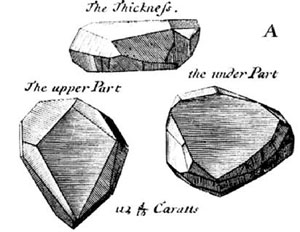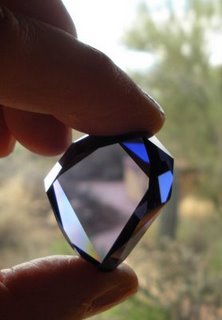Tavernier Blue on:
[Wikipedia]
[Google]
[Amazon]
 The Tavernier Blue was the precursor diamond to the Blue Diamond of the French Crown (aka the French Blue). Subsequently, most scholars and historians believe that it was re-cut and, after a disappearance and reemergence into the public forum, was renamed the
The Tavernier Blue was the precursor diamond to the Blue Diamond of the French Crown (aka the French Blue). Subsequently, most scholars and historians believe that it was re-cut and, after a disappearance and reemergence into the public forum, was renamed the
 Tavernier was a French traveler and trader who returned to France from India with many of the largest gems of the era. He primarily sold merchandise to French royalty and the aristocracy. Tavernier sold the Tavernier Blue to
Tavernier was a French traveler and trader who returned to France from India with many of the largest gems of the era. He primarily sold merchandise to French royalty and the aristocracy. Tavernier sold the Tavernier Blue to  The French Blue was stolen from the French Crown Jewels in 1792 during the turbulence of the
The French Blue was stolen from the French Crown Jewels in 1792 during the turbulence of the
 The Tavernier Blue was the precursor diamond to the Blue Diamond of the French Crown (aka the French Blue). Subsequently, most scholars and historians believe that it was re-cut and, after a disappearance and reemergence into the public forum, was renamed the
The Tavernier Blue was the precursor diamond to the Blue Diamond of the French Crown (aka the French Blue). Subsequently, most scholars and historians believe that it was re-cut and, after a disappearance and reemergence into the public forum, was renamed the Hope Diamond
The Hope Diamond is a diamond originally extracted in the 17th century from the Kollur Mine in Guntur, India. It is blue in color due to trace amounts of boron. Its exceptional size has revealed new information about the formation of diamonds. ...
. It is believed to have been a Type IIb diamond.
Diamond details
Weighing 112 3/16 old French carats, the crudely finished gem was described by the French gem dealerJean-Baptiste Tavernier
Jean-Baptiste Tavernier (1605–1689) was a 17th-century French gem merchant and traveler. Tavernier, a private individual and merchant traveling at his own expense, covered, by his own account, 60,000 leagues in making six voyages to Persia ...
as being "violet" in color. and of perfect clarity. The diamond was certainly Indian in origin and likely sourced by Tavernier in 1666 at the Kollur mine
Kollur Mine was a series of gravel-clay pits on the south bank of the Krishna River in the Golconda Sultanate of India. It currently falls within the state of Andhra Pradesh. It is thought to have produced many large diamonds, known as Golcond ...
in the Guntur district, Andhra Pradesh
Andhra Pradesh (, abbr. AP) is a state in the south-eastern coastal region of India. It is the seventh-largest state by area covering an area of and tenth-most populous state with 49,386,799 inhabitants. It is bordered by Telangana to the ...
. The stone, only slightly finished at this time, was eventually cut to present a more diamond-like appearance, in 1775.
Background and history
 Tavernier was a French traveler and trader who returned to France from India with many of the largest gems of the era. He primarily sold merchandise to French royalty and the aristocracy. Tavernier sold the Tavernier Blue to
Tavernier was a French traveler and trader who returned to France from India with many of the largest gems of the era. He primarily sold merchandise to French royalty and the aristocracy. Tavernier sold the Tavernier Blue to Louis XIV of France
, house = Bourbon
, father = Louis XIII
, mother = Anne of Austria
, birth_date =
, birth_place = Château de Saint-Germain-en-Laye, Saint-Germain-en-Laye, France
, death_date =
, death_place = Palace of ...
for cash. He also received a Patent of Nobility
Letters patent ( la, litterae patentes) ( always in the plural) are a type of legal instrument in the form of a published written order issued by a monarch, president or other head of state, generally granting an office, right, monopoly, titl ...
as part of the sales price.
The original stone was set into a cravat-pin in 1674, and became a central element in the elaborate Order of the Golden Fleece pendant in 1715. It and the fleece were placed into the French Crown Jewels in 1749. The Tavernier Blue was removed from the fleece and re-cut by court jeweler Jean Pitau into the 68-carat French Blue in 1775, on the orders of Louis XV
Louis XV (15 February 1710 – 10 May 1774), known as Louis the Beloved (french: le Bien-Aimé), was King of France from 1 September 1715 until his death in 1774. He succeeded his great-grandfather Louis XIV at the age of five. Until he reached ...
. It was then returned to the Crown Jewels.
 The French Blue was stolen from the French Crown Jewels in 1792 during the turbulence of the
The French Blue was stolen from the French Crown Jewels in 1792 during the turbulence of the French Revolution
The French Revolution ( ) was a period of radical political and societal change in France that began with the Estates General of 1789 and ended with the formation of the French Consulate in coup of 18 Brumaire, November 1799. Many of its ...
. It is generally believed that after the theft, the stone was cut into the 45.52-carat Hope Diamond
The Hope Diamond is a diamond originally extracted in the 17th century from the Kollur Mine in Guntur, India. It is blue in color due to trace amounts of boron. Its exceptional size has revealed new information about the formation of diamonds. ...
and several smaller stones in an attempt to prevent its proper identification. This provenance was accepted by many historians and gemologists for years and was supported by research with 3D imaging and prototyping technology in 2005.
Possible remnants
Another large blue diamond believed to have been taken from the Tavernier was originally set in a ring for Empress Maria Feodorovna, wife of RussianEmperor Paul I
Paul I (russian: Па́вел I Петро́вич ; – ) was Emperor of Russia from 1796 until his assassination. Officially, he was the only son of Peter III and Catherine the Great, although Catherine hinted that he was fathered by her l ...
. It was given to the State Diamond Fund in 1860 by her daughter-in-law, the Empress Alexandra Feodorovna. Later, it was mounted into a stick pin. The 7.6-carat stone is preserved in the collection of the Alexander Palace in Tsarskoye Selo
Tsarskoye Selo ( rus, Ца́рское Село́, p=ˈtsarskəɪ sʲɪˈlo, a=Ru_Tsarskoye_Selo.ogg, "Tsar's Village") was the town containing a former residence of the Russian imperial family and visiting nobility, located south from the c ...
, near St Petersburg. The Russian stone's provenance as part of the Tavernier Blue is disputed.
See also
*List of diamonds
Diamonds become famous typically for some combination of their size, color and quality. Diamonds occur naturally in many different colors, so the largest diamond of a particular color may not be large in absolute terms, but it may still be consid ...
Notes
References
Externalink link
{{Commonscatinline Diamonds originating in India Blue diamonds Individual diamonds